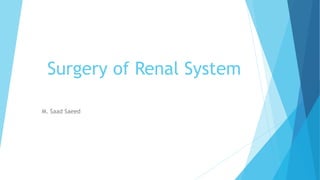
Surgery of renal/ urinary system
- 1. Surgery of Renal System M. Saad Saeed
- 2. Kidney surgery Also known as: Nephrectomy, Radical Nephrectomy, Partial Nephrectomy, Nephron Sparing Surgery, Percutaneous Nephrolithotomy, Percutaneous Nephrolithotripsy Kidney surgery is performed to treat a variety of conditions and is usually performed by a urologist.
- 3. SPECIAL INSTRUMENTS Absorbable suture material, such as polydioxanone (PDS), polyglyconate (Maxon), poliglecaprone 25 (Monocryl), or glycomer 631 (Biosyn), should be used in the kidney, ureter, and bladder. Nonabsorbable suture material may promote formation of calculus and infection. Although PDS and Maxon maintain tensile strength and are more slowly absorbed than is desirable for most urinary surgery, they have less tissue drag than multifilament suture. The use of pediatric or ophthalmic instruments facilitates surgery of the ureter. These instruments tend to be smaller and more delicate and may cause less tissue trauma than larger instruments.
- 4. Conditions kidney cancer; chronic kidney diseases; kidney stones (removal); kidney infection; renal hypertension; traumatic kidney injury; kidney donation
- 5. Nephrectomy and Radical Nephrectomy Nephrectomy is the surgical removal of a kidney. A radical nephrectomy is the removal of one entire kidney, surrounding lymph nodes, and the adrenal gland and is usually performed as a first step in treating kidney cancer. After removal of a kidney, patients can lead normal, healthful lives, as long as the remaining kidney is functioning well.
- 6. Partial Nephrectomy Or Nephron- sparing Surgery (NSS) With partial nephrectomy or nephron sparing surgery (NSS) only the tumor and tissue immediately surrounding the tumor is removed. This type of kidney surgery is most often done as a first step in certain kidney cancers and when it is important to maintain kidney function. For partial nephrectomy, use large, absorbable suture with two long, straight needles attached.
- 7. Nephrotomy Nephrotomy usually is performed to remove calculi lodged in the renal pelvis. Make a sharp incision along the capsule of the convex border of the kidney, and bluntly dissect the renal parenchyma to the renal pelvis. Remove the calculi and close the nephrotomy by apposing the cut tissue and suturing the capsule in a continuous pattern with absorbable suture material (see text for sutureless technique). If adequate hemostasis is not achieved, or if urine leakage is a concern, place absorbable sutures through the cortex in a horizontal mattress fashion. Then suture the capsule in a continuous pattern with absorbable suture material.
- 8. Nephrotomy
- 9. Pyelolithotomy Dissect the kidney from its sublumbar attachments and expose the dorsal surface. Identify the ureter and renal vessels (A). Make an incision over the dilated pelvis and proximal ureter, and remove the calculi (B). Flush the renal pelvis and diverticula with warm saline to remove small debris. Next, flush the ureter to ensure its patency. Close the incision in a continuous pattern with 5-0 or 6-0 absorbable suture (C)
- 10. Ureterotomy Make a transverse or longitudinal incision in the dilated ureter proximal to the calculi and remove them (A). Place a small, soft rubber catheter into the ureter proximal and distal to the incision, and flush the ureter with warm fluid. Make sure that all calculi have been removed and that the ureter is patent. Close the incision in a simple interrupted pattern with 5-0 to 7-0 absorbable suture (B). As an alternative, if the ureter is not dilated and if stricture formation seems likely, make a longitudinal incision over the calculi and close the incision in a transverse fashion (C).
- 11. Cystotomy Isolate the bladder from the rest of the abdominal cavity by placing moistened laparotomy pads beneath it. Place stay sutures on the bladder apex and trigone to facilitate manipulation (A). Make a longitudinal incision in the ventral or dorsal aspect of the bladder, away from the ureters and urethra, and between major blood vessels. Remove urine by suction or perform intraoperative cystocentesis before cystotomy if suction is not available. Excise a small section of the bladder wall adjacent to the incision to submit for aerobic culture. Check the bladder apex for a diverticulum, and excise it if necessary. Examine the mucosa for defects, and pass a catheter down the urethra to check for patency. Close the bladder in a single layer using a continuous suture pattern with absorbable suture material (see previous discussion). For a two-layer closure, suture the seromuscular layers with two continuous inverting suture lines (e.g., Cushing, followed by Lembert; (B). If the dog has severe bleeding tendencies, consider suturing the mucosa as a separate layer with a simple continuous suture pattern.
- 12. Cystotomy .
- 13. Percutaneous Nephrolithotomy/ Nephrolithotripsy (tunnel surgery) Percutaneous nephrolithotomy and nephrolithotripsy are both used to remove kidney stones. In both procedures the surgeon accesses the kidney through a small incision in the back and threads a nephroscope (a miniature fiberoptic camera) and other small instruments through the hole. The surgeon can then remove an intact stone through the tube (nephrolithotomy) or will break up the stone first before removing it (nephrolithotripsy).
- 14. Extracorporeal Shock Wave Lithotripsy (ESWL or lithotripsy) Lithotripsy is a non-invasive medical procedure that uses shock (sound) waves to break up stones in the kidney, bladder, or ureter (tube that carries urine from the kidneys to the bladder). It is normally done under general anesthesia or mild sedation and on an outpatient basis.
- 15. Open vs. Minimally Invasive Surgery Open, or traditional, surgery usually involves an incision in the abdomen or side, although some procedures access the kidney through the lower back. Minimally invasive procedures allow access to the kidney through smaller incisions and the use of a laparoscope and special tools to view and work on the kidney. Benefits of minimally invasive procedures include decreased blood loss, less pain and faster recovery. There might be increased risks as well and not all surgeries can be done as minimally invasive. Patients should always discuss their surgical options and associated risks with their surgeon before undergoing any type of surgery.